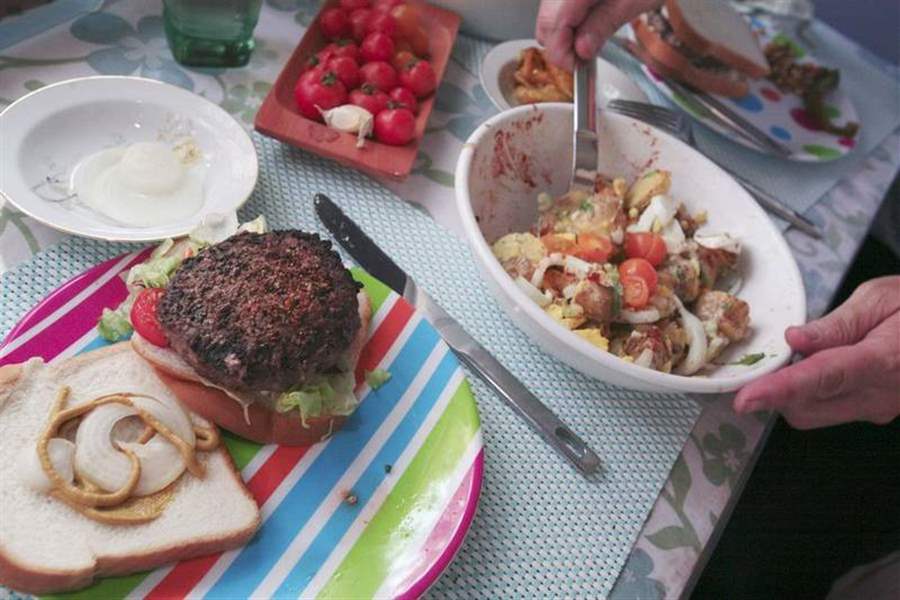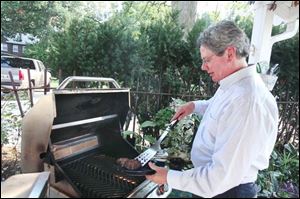
Commissioners dine lightly on $21 weekly limit
9/25/2007
The Gerkens' menu for the challenge's last day included food from their garden and ears of corn, as well as hamburgers.

'Probably as the week went on, the thing that got my attention the most was trying to get the most nutritional value for the money,' says Commissioner Pete Gerken, grilling hamburgers for himself and his wife on the final day of the challenge.
For Tina Skeldon Wozniak, sharing a burrito with her husband in a restaurant over the weekend was an incredible luxury.
Pete Gerken came to view the free coffee in an auto dealership as a coveted guilty pleasure.
And Ben Konop didn't eat for a whole day and he still had to rely on the kindness of others.
The three Lucas County Commissioners today will finish a seven-day challenge to eat on $21 for the week, the average amount that food stamp recipients receive through the supplemental federal program.
Each said yesterday that the exercise was tough, demanding, and eye-opening.
"I ran out of food," Mr. Konop said yesterday. "I ran out of turkey. All I have left is granola bars."
Mr. Gerken said he was amazed at the challenges he faced during the week.
"It's about stepping out of yourself, out of your own routine, to see what someone else's challenges are," Mr. Gerken said. "It really was a powerful way to think about food. Probably as the week went on, the thing that got my attention the most was trying to get the most nutritional value for the money."

The Gerkens' menu for the challenge's last day included food from their garden and ears of corn, as well as hamburgers.
Like Mr. Gerken and Mr. Konop, Mrs. Wozniak said she finished the challenge mostly with the help of her friends.
"If it wasn't for the generosity of others, we wouldn't have made it," Mrs. Wozniak said. "Two people invited us over for dinner. The neighbors across the street brought us fresh veggies from their garden. And later in the week, they brought us some bananas."
The challenge that the commissioners accepted last week has become increasingly popular among elected officials who hope to draw attention to what they see as the program's deficiencies. Several members of Congress have taken the challenge, as have other federal, state, and local elected officials.
Mark Lino is an economist with the U.S. Department of Agriculture, which oversees the food assistance program. He said that the $21 figure used in such challenges may be an accurate representation of the average received by food stamp recipients, but the figure doesn't include other income that would be used for food in such circumstances.
"It is possible to eat a nutritious diet at a low cost," Mr. Lino said. "You couldn't do that [$21 per week] for an adult. That's low." He said focusing one's shopping on foods like bananas, apples, potatoes, and spinach, that are relatively cheap compared to their nutritional content is the key to eating healthy on a tight budget.
Mr. Lino said that the USDA estimates that, using national averages for food costs, it would take $126 per week to feed a family of four using a nutritious diet that conforms to the USDA's food pyramid.
The Rev. Kevin Perrine, program director of Toledo Area Ministry Feed Your Neighbor Program, originally issued the challenge to the three commissioners. He said their exercise was worthwhile, even if it didn't fully immerse the three commissioners into what true poverty is like.
"The challenge really has nothing to do with the amount," Mr. Perrine said. "What we're trying to do is make the leaders more aware of this issue, that it's in Toledo, and that it's something very prevalent right now."
The Feed Your Neighbor program usually helps about 60,000 families a year, Mr. Perrine said. This year, the number of individual families being assisted by the nonprofit program has increased about 20 per cent.
"There are people in a great deal of need," Mr. Perrine said. "Food stamps is a supplemental, just like our program."
Mr. Gerken said he was amazed to discover the "politics" of food, and how the cheapest items in the store weren't necessarily the best buy.
"I'll give you one example: yogurt," he said. "The 40-cent yogurt had 23 grams of sugar in it, while the one for a dime more only had 7 [grams]. My attitude toward food and food distribution has been changed forever. I won't forget it."
Mrs. Wozniak, who took the challenge along with her husband, Russ, and son, Aaron, said she took some heat for her purchases from some of the public when a photograph of her shopping cart was published last week in The Blade.
"I got a half-dozen e-mails questioning the choices I made from the picture of the food in my cart," Mrs. Wozniak said. "Mostly people appreciated that we took the challenge, but there were a few people whose e-mails were less supportive than others."
Mr. Konop said he blew the challenge almost right out of the box when he only had 20 minutes to purchase the groceries he would eat for the week and spent $22.33 at the grocery store.
"I was trying to do this as healthy as possible, but I didn't have time at the store to research what I was buying," the young commissioner said. "I assume that's a common problem that anyone in this situation has."
He ran out of food, he said, even though he fasted for 24 hours over the weekend for religious reasons.
"I've been relying on the generosity of family and friends to feed me," Mr. Konop said.
Mr. Konop said he and his fellow commissioners received a large amount of feedback on their experiment, both positive and negative.
"In a way, whatever controversy was generated was probably [positive], because it brought attention to an issue that usually doesn't get any attention," Mr. Konop said. "I thought it exposed a bit of a dark side on some people, and just some mean-spiritedness. But the vast majority of feedback has been positive."
Contact Larry P. Vellequette at:
lvellequette@theblade.com
or 419-724-6091.